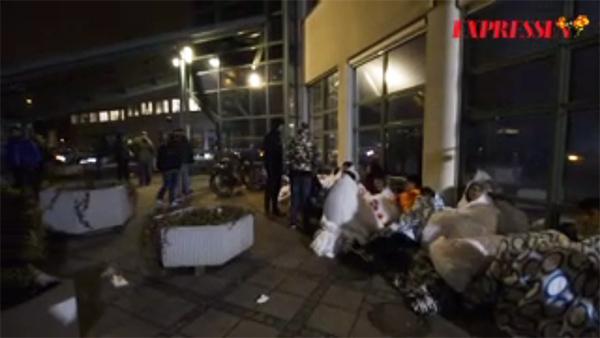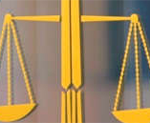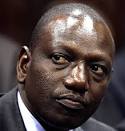Sweden: Shambles in Asylum Heaven by Ingrid Carlqvist

-
In Sweden, only the people who say they are not applying for asylum are checked.
-
-
To avoid having to show any papers, a terrorist going to Sweden to commit acts of terror only has to tell the border police that he is seeking asylum. He will immediately be driven to the closest Immigration Service facility. And while the Immigration Service tries to figure out who he is, he can plan his attacks in the peace and quiet of the Swedish countryside.
-
“The truth is that persons with evil intent know exactly what to do when they come here. That information spreads like wildfire. These new border controls are there for the sole purpose of reassuring the public. They have absolutely no effect on the influx of migrants.” — Border policeman at the Öresund Bridge (between Denmark and Sweden).
-
Despite many Swedes drawing a sigh of relief when the government announced that immigration was to be limited, the new policy does not really entail any difference at all.
In spite of the supposedly tighter asylum rules announced November 24, chaos rules in Sweden. So far, in 2015, 150,000 asylum seekers have been registered; but as there is nowhere to house them, people are sleeping in tents, on cardboard boxes in exhibition halls, and even on the street. Many run away from the Immigration Service facilities. More than22,000 people are supposed to be deported but refuse to leave. Swedes are understandablyterrified that terrorists might be hiding among the refugees. The police are busy with pointless border controls and cannot attend to their normal work. It is not an exaggeration to say that in this situation, Sweden has lost track of pretty much everything.

Some homeless migrants now sleep on the street in Sweden. (Image source: Expressen video screenshot) |
Even the asylum seekers are complaining. On a Swedish public television program, Uppdrag Granskning, aired on December 2, Salwa, a mother of young children, told the reporter how she is forced to live in an asylum house along with men she called “bad people.” When the reporter explained to Salwa that 10,000 new asylum seekers arrive every week, and this was why everything was topsy-turvy, she replied: “Then close the borders. Stop taking in more people. If you have ten guests in your house and there is not enough room, would you still take in ten more?”
Sweden’s Social Democrat Prime Minister, Stefan Löfven, said in an interview last April with the daily Sydsvenskan,
“There is no limit [to the number of refugees Sweden can accept]. We will accept refugees according to the conventions that bind us. We have done it before. In the early 1990s, many came from the former Republic of Yugoslavia. Today, they are a natural part of the Swedish society. They contribute a lot.”
So, when Prime Minister Löfven and Vice Prime Minister, Åsa Romson (Green Party) presentedtheir new, tougher immigration policy on November 24, it sent shockwaves through the Swedish establishment. Journalists, who never asked the governing politicians a single critical question about their affinity for open borders, now appeared stunned — despite one authorityafter another, during the last few months, having warned of an imminent systemic collapse. When Romson started crying during the live press conference because, she said, she was “forced” to be a part of the tightening of the world’s most generous immigration policy, everyone believed that these new immigration rules must be for real.
The message conveyed to the Swedish people on November 24 was that the borders were now essentially being shut; that Löfven had discovered there was a limit. The political party most critical of immigration policy, the Sweden Democrats (Sverigedemokraterna), declaredvictory. Its party leader, Jimmie Åkesson, immediately reached out to the Conservatives (Moderaterna) and the Christian Democrats (Kristdemokraterna), offering to bring down the government and form a new one together with them. This invitation was immediately declined. The reply should probably be viewed in the light of all seven parties in Parliament having vowednever to co-operate with the “xenophobic” Sweden Democrats.
It does not matter, therefore, that the other parties have now adopted much of the Sweden Democrats’ policies, or that many Conservatives actually want to take them even further and could easily get them through Parliament by forming a government with the Sweden Democrats.
An outsider may get the impression that every party in Sweden is now competing over who can suggest harsher austerity measures. The Conservatives say they want, among other things, to stop people who are coming from other EU countries from applying for asylum in Sweden. The Conservatives also say they want new measures for deporting those who have had their application rejected. The government is already negotiating with Afghanistan to try to persuade it to take back some of the many Afghans (36,261 in total; 20,947 supposedly “children”) who applied for asylum in Sweden this year.
So far, no journalist in the mainstream media seems to have discovered that the new border controls — implemented because the government evidently decided there is “a serious threat to public order and safety in the country” — have had no discernible effect. The media still give the public the impression that asylum seekers are actually stopped at the border, and that, as the Minister for Justice and Migration, Morgan Johansson, announced, all border crossings will be controlled before Christmas.
As noted last month, however, to avoid having to show any papers, a terrorist going to Sweden to commit acts of terror only has to tell the border police he is seeking asylum. He will immediately be driven to the closest Immigration Service facility. While the Immigration Service tries to figure out who he is, he can plan his attacks in the peace and quiet of the Swedish countryside. And as it takes the Immigration Service 222 days, on average, to establish a plausible identity, he need not be in any hurry.
One person who has grown tired of this whole charade is actually one of the Border Police at the Öresund Bridge (between Denmark and Sweden). He told Gatestone Institute that every day, the new controls cause a number of people — many of whom had planned on passing through Sweden to seek asylum in Finland or Norway — to return to Denmark of their own volition. But, he said, it is rare that someone refuses to show identification or apply for asylum, and thus be turned down.
“The truth is that persons with evil intent know exactly what to do when they come here,” he said.
“That information spreads like wildfire. These new border controls are there for the sole purpose of reassuring the public. They have absolutely no effect on the influx of migrants. The public is given a completely erroneous picture of what we are doing. They do not understand that we spend enormous amounts of time checking Swedish and Danish commuters. If we do not, the press goes crazy and starts screaming about discrimination.
“It seems as if those in power do not want the people who are here illegally to be deported. They give them free health care, free dental care, and schooling for their children. It is mixed messages all the time. I think they need to make up their minds about what they want. These controls mean nothing. They are just a formality to make everything look good and avoid discriminating against anyone. We should put our time and effort where they are needed.”
When asked by Gatestone why the police were allocating enormous resources to border controls that in fact do not amount to anything, the Press Officer at the Swedish National Police Agency (Rikspolisstyrelsen), Stephan Ray, stated that he did not have time to discuss it because he needed to go to the bathroom; then hung up the phone.
An expert on international law, who asked to remain anonymous, told Gatestone that he could no longer understand what the government was thinking by allowing potentially dangerous people into Sweden. Nowhere in any international conventions, he said, does it say that the right of asylum takes precedence over the security of a country’s own population. The most reasonable thing to do, he said, would be to establish fenced-in refugee camps near the borders and not let the asylum seekers out until it was determined that they were not terrorists or war criminals: “According to the Refugee Convention of 1951,” he said, even if people are war criminals and risk facing the death penalty at home, a country has the right to send them back.”
Even so, convicted murderers and war criminals — happily for them — get to stay in Sweden. The rule is that no one risking the death penalty or persecution in their home country will be sent back. This includes even people who have committed capital crimes in Sweden and been sentenced to deportation. It is uncertain that the IKEA-murderer, Abraham Ukbagabir, can be deported to Eritrea after serving his time in prison. There are, apparently, “hindrances” to enforcing deportations to Eritrea. Recently, the alternative-media site, Nyheter Idag, revealedthat, as there are “hindrances” to deporting people to Syria, terrorists discovered to be Islamic State combatants seeking asylum will get to stay in Sweden.
When Gatestone asked the Immigration Service why it was more concerned about the safety of foreign citizens than the lives of Swedish citizens, Matilda Niang of the Immigration Service press office replied that it would be inhumane to lock up asylum seekers until their identity had been established. “A lock-up,” she said, “would also affect asylum seekers who did not commit any crimes.”
So, despite many Swedes drawing a sigh of relief when the government announced that immigration was to be limited, the new policy does not really entail any difference at all.
No sitting politician has yet expressed doubt about the wisdom of turning Sweden from a Swedish country into a multicultural one, and none has yet said the policy of importing migrants needs to stop.
It may well be that the government’s measures are only a facade, designed to soothe the Swedish people, in the hope of relieving some of the pressure.
Among these new measures are:
- A moratorium on permanent residency status. From now on, a residency status is valid for three years, with an option for a one-year extension. Permanent residency is given only to persons who, after this time, are able to support themselves financially.
- Stricter limits on bringing in relatives.
- Tightening demands on self-sufficiency and the ability to support financially one’s own family.
- Medical determination of so-called unaccompanied refugee children.
- Identity checks on all public transport: everyone on a ferry, train, or bus to Sweden must show a passport or a driver’s license.
The temporary residency is a message that will reach migrants quickly. Whether or not this means that fewer people will get to stay is doubtful. Nothing prevents the government from transforming the temporary residencies into permanent ones after the four years expire. There will also be the problem of what to do with migrants who do not leave at that point. Medically determining the age of the many Afghans who claim to be under 18, in order to get a fast track on their asylum application, might have some effect. Sweden’s failure to age-test asylum seekers has led to an avalanche of “bearded children.” Each week, over 1,000 “children” arrive, of whom 80% come from Afghanistan. In Denmark, where age-testing has been routine, it turned out that at least 50% of these so-called children were in fact adults; and in Norway and Finland, this number was 66%.
About 75% of all the “children” who apply, are granted asylum in Sweden. It is therefore extremely popular, when seeking asylum, to claim to be under 18. In 2013, 4,000 arrived. In 2014, the number was 7,000; and during the first eleven months of 2015, a staggering 32,180“unaccompanied refugee children” sought asylum in Sweden. More than half were from Afghanistan; the second largest group was from Syria, followed by Eritrea and Somalia. About 2,000 were girls.
A few days after the announcement of Sweden’s new asylum rules, the influx of migrants slowed significantly. On November 28 and 29, from a peak of about 1,500 a day, only 392 and 375 people, respectively, were registered. Most were from Afghanistan, Syria and Iraq. The next day, however, the number of applications once again jumped to more than 1,000.
An intelligence analyst at the Immigration Service, Anders Westerlund, told the dailyAftonbladet that the decline was most likely due to fewer refugees arriving on the Greek isles from Turkey. “We also see that tougher border controls in the Balkans, and the cold weather, are keeping people from coming to Europe,” he said. “Winter is coming, and that makes the journey riskier.”
Meanwhile, police are swamped with pointless border controls and cannot do their usual work, and criminals roam the streets.
District Attorneys [DAs] apparently have so little to do, that they recently promised to supply the Immigration Service with 30 underemployed DAs. The Immigration Service, despite having recently hired another 1,200 employees, is, of course, struggling to cope with the current situation. In total, Immigration Service staff wages cost the Swedish taxpayers 250 million kronor (about $29,000,000) a month, or about 3 billion kroner (about $350,000,000) a year.
“We can lend them 30 DAs and clerks,” chief prosecutor Solveig Wollstad said in an interview with Gatestone, “because our influx of cases has gone down. The police are busy doing other things, such as fighting terrorism and taking care of migrants.”
When asked if the situation was possibly due to crime going down, Wollstad said, “No, no, no. The decrease is due to the police working so much with other things, such as preventing terror and dealing with the refugee flow. More police are needed at the borders now. Sweden is in crisis. It is not just us who are lending out staff: it is also the National Courts Administration, the Enforcement Authority, the Prison and Probation Service and a number of other authorities.”
In short, the only discernible effect of the “humanitarian superpower’s” new asylum rules is that the Swedish police are busy checking the identities of people who do not want to seek asylum in Sweden, and therefore lack the resources to apprehend criminals.
“As long as the ingrained rhetoric in Sweden is viewed as a manifestation of divinity and goodness,” writes Associate Professor of Business Administration and author Jan Tullberg in a recent article, “political ineptness will continue paralyzing the country.”
Ingrid Carlqvist is a journalist and author based in Sweden, and a Distinguished Senior Fellow of Gatestone Institute.























